
The Farwell Mill is an historic former mill complex at 244 Lisbon Street in Lisbon, Maine. Built in 1872, it is a fine example of a cotton mill built at the height of the Industrial Revolution. It was listed on the National Register of Historic Places in 1985. It is now residential housing.

The Webster Rubber Company Plant, formerly the Webster Woolen Mill No. 1-1/2, is an historic industrial site on Greene Street in Sabattus, Maine. Built in 1869 as a textile mill, it was a fixture of the town's economy well into the 20th century, and is good local example of industrial Italianate architecture. The property was listed on the National Register of Historic Places in 1989. In 2015, the property was vacant, and it was demolished in 2018.

The Old Mill Site Historic District in Hatfield, Massachusetts encompasses the site of a late 19th century mill. It is one of only two such sites in the town. The centerpiece of the district is the former Shattuck Gun Factory building, which in 1989 housed newspaper offices and in 2006 a bed and breakfast. The district, which was listed on the National Register of Historic Places in 1982, includes three other elements: an 1891 Warren pony truss bridge across the Mill River, now closed to traffic, and a machine shop and garage, both built in 1886. The district was also included in the larger Mill-Prospect Street Historic District in 2002.

The Perkins Tide Mill was one of the last surviving 18th-century tide mills in the United States. Located on Mill Lane in Kennebunkport, Maine, it was built in 1749 and operated until 1939. It was destroyed by an arsonist in 1994. Listed on the National Register of Historic Places in 1973, the property's present owners, the Kennebunkport Conservation Trust, are contemplating construction of a replica.
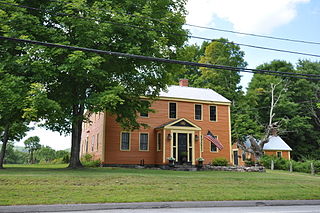
The Burnell Tavern is an historic former tavern on Maine State Route 113 in West Baldwin, Maine. Built in 1737, it is the oldest building in the rural community, and has long been a local landmark. It was listed on the National Register of Historic Places on December 29, 1983. It is now a private residence, not open to the public.

The Jaffrey Mills is a historic mill complex at 41 Main Street, in the central business district of Jaffrey, New Hampshire. It consists of a connected series of primarily brick buildings flanking the Contoocook River just north of Main Street. Its oldest buildings, the original mill and office building, are on the west side of the river. They were built in 1868, and feature mansard roofs and banded dentil brick cornices. The mill building has a tower that originally sported a cupola, but this was removed early in the 20th century. In 1872 the building on the east side was built, and the two sides joined by timber-frame bridges were added in 1897, at the same time the east building was extended northward. Later additions to the north of the east building include a storage area and a loading dock. The mill complex, the only 19th-century industrial complex of its type to be built in Jaffrey, was listed on the National Register of Historic Places in 1982. It has been converted into residences.

The Contoocook Mills Industrial District of Hillsborough, New Hampshire, encompasses the industrial mill complex of the Contoocook Mills, a major business in the town from the 19th century to the mid-20th century. Industry on the banks of the Contoocook River in Hillsborough began as early as 1763, when a sawmill and gristmill were operated in the area. More modern industrial activity began in 1828 with the construction of a cotton mill by Josiah Marcy. This three story timber frame building stands on the south side of Mill Street, on a granite foundation through which a raceway provide the water which powered the mill. Marcy expanded his operations, building a grist mill and saw mill before his death in 1848. The grist mill, a handsome brick building on the north side of Mill Street, was operated as such until 1884, after which it was converted into the picker building for the main mill complex.

The Churchill Bridge is a historic bridge carrying Mountain Road over Bicknell Brook, in a rural corner of Buckfield, Maine. It is one of three documented stone lintel bridges in the state. It is a dry laid rubble stone structure which carries the road over the stream at a height of about 14 feet (4.3 m). The total length of the bridge is about 20 feet (6.1 m), and the clear span over the brook is 5 feet (1.5 m). The span is formed by five massive ledge stones laid on rubble abutments about 7 feet (2.1 m) above the stream. Additional rubble is laid above to form the bed of the gravel roadway. The bridge crosses the stream at a slight angle, so its abutments are extended with wingwalls to the northwest and southeast.
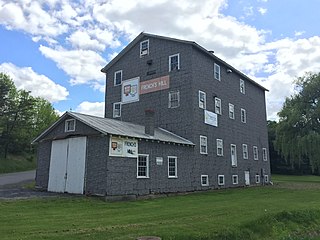
French's Mill is a historic grist mill at the junction of Augusta-Ford Hill and Fairground Roads in Augusta, West Virginia. Its main building is a three-story wood-frame building with a metal roof, asphalt siding, and a concrete foundation. It was built in 1911 on the site of a c. 1890s grist mill that was destroyed by fire. The mill, which was originally water-powered, was converted to operate by electric power in 1949, and ceased operations in 2000. It was also updated in the mid-20th century to accommodated different types of grain, illustrating the evolutionary change of these industrial facilities.

The Squire Ignatius Haskell House is a historic house at 20 Main Street in the center of Deer Isle, Maine. Now home to the Pilgrim's Inn, this wood-frame house was built in 1793 by one of the maritime community's leading men, and is one of its oldest buildings. It was listed on the National Register of Historic Places in 1978.
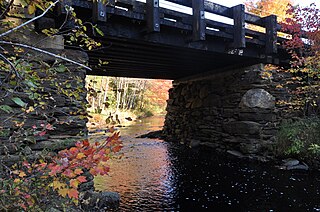
The Grist Mill Bridge is a historic bridge in Lebanon, Maine, carrying Little River Road across the Little River. Although the bridge has a 20th-century wooden deck on rubblestone abutments and pier, it is functionally similar to the bridge's original deck, which was also a wooden structure that may have existed as early as 1774. The bridge was listed on the National Register of Historic Places as a rare example of a bridge in the state with some essential 18th-century elements intact.

The Sanford Mills Historic District encompasses a large industrial complex in the center of Sanford, Maine, United States. From 1867 to 1955, the property was the site of a major textile manufacturing operation that was a major local employer. The site, flanking the Mousam River just north of Sanford's central business district, was listed on the National Register of Historic Places in 2009.
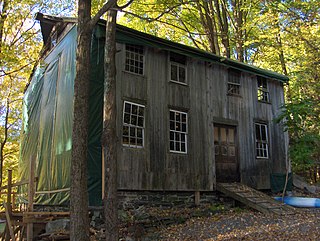
Gillette's Grist Mill is a historic grist mill on Maple Hollow Road in New Hartford, Connecticut. Probably built in the mid-19th century, it is an extremely rare example of a grist mill with a surviving water wheel. The mill property was added to the National Register of Historic Places in 1977.

The Mill at Freedom Falls is a historic mill complex at Mill and Pleasant Streets in Freedom, Maine. The main building, constructed in 1834, is the only mill built at this site, and the only one to survive nearly unaltered in the village. The mill and its surviving dam were listed on the National Register of Historic Places.

The Dexter Grist Mill, now the Dexter Historical Society Museum, is a historic 19th-century industrial property in Dexter, Maine. Built in 1854, the mill was operated by a single family for over a century, and was converted to a museum in 1967. It was listed on the National Register of Historic Places in 1975.

The Lermond Mill, now also known as Morgan's Mill, is a historic mill complex on Payson Road in Union, Maine. With a history dating to the late 18th century, and its present buildings from the early 19th century, it is one of the oldest operational water-powered mills in the state of Maine. It was listed on the National Register of Historic Places in 1984. As of 2006, it was reported to be in use for power generation and as a grist mill.
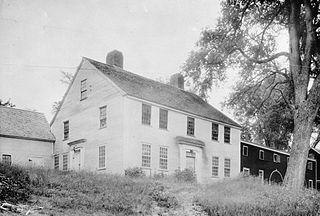
The Head Tide Historic District encompasses a formerly industrial, now rural village at the head of tide of the Sheepscot River in Alna, Maine. The area had been industrially active since the mid-18th century, but its mills declined and were all destroyed by 1949, leaving a predominantly residential area with a number of houses dating mainly to the period before 1860. The district was listed on the National Register of Historic Places in 1974.

The East Vassalboro Grist and Saw Mill is a historic mill complex in East Vassalboro, Maine. Established in the late 18th century, it is one of the oldest water-powered mills in the state, with a working complement of grist and lumber milling equipment. It was listed on the National Register of Historic Places in 1982.
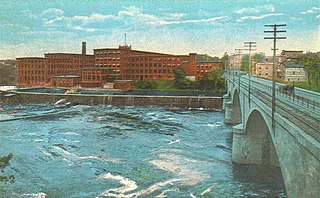
The Lockwood Mill Historic District encompasses the only major 19th-century mill complex in Waterville, Maine. Located south of the city's downtown, it was designed by Amos D. Lockwood, a nationally known industrial designer of the period. Its #2 building was for 45 years home to the Hathaway Shirt Company. It was listed on the National Register of Historic Places in 2007.

The Southard Block is a historic commercial building at 25 Front Street in the village center of Richmond, Maine. Built in 1882, it is one of the small community's prominent commercial buildings, with distinctive Second Empire styling. It was built by T.J. Southard, the town's leading shipbuilder of the period. It was listed on the National Register of Historic Places in 1972.




















